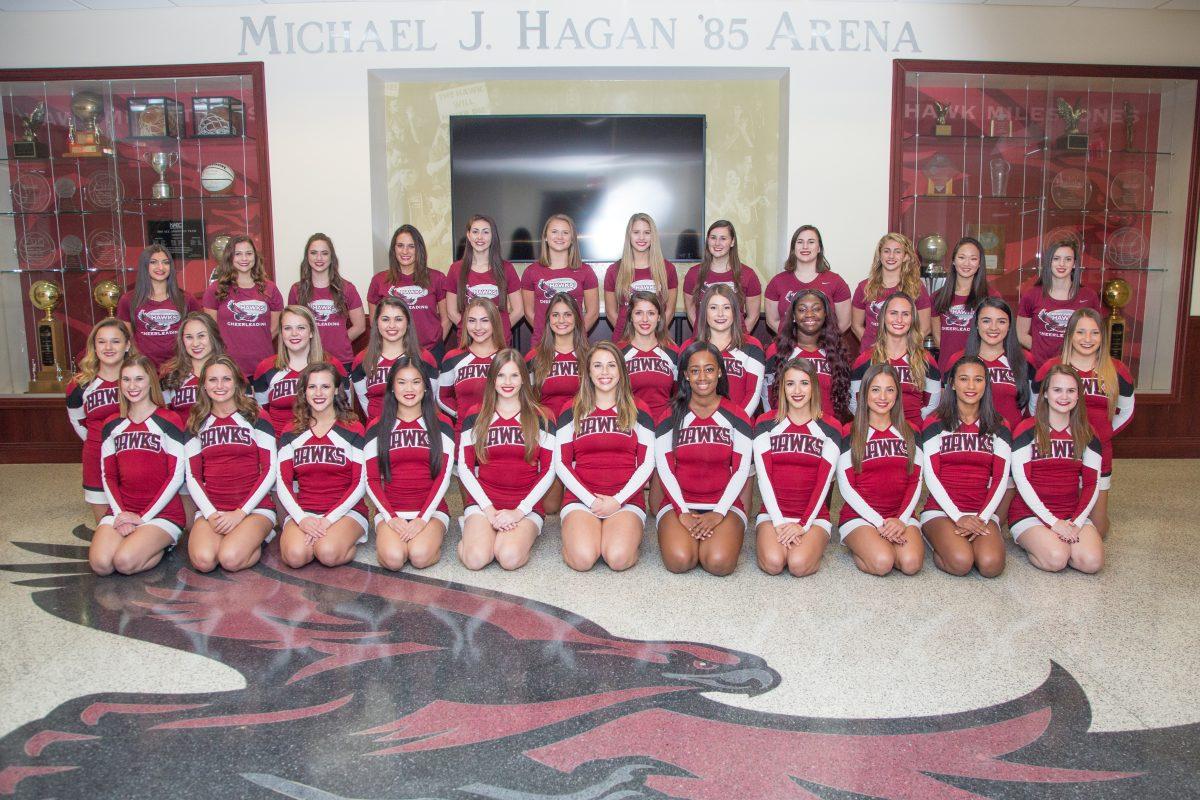A look at the lack of appreciation for cheerleading and women’s sports
To our peers, cheerleaders seem to only exist as a stereotype: high ponytails clad in gaudy ribbon, crimson skirts, cumbersome pompoms and that textbook hyperbolic smile. Despite the long nights in the Hagan Arena practice gym or the early mornings spent with trainers, we have been reduced and equated only to our exterior glamour. Our identity as athletes has somewhere along the way morphed into a notion that a team 40 members strong is simply a sideline accessory for basketball players on game day.
We have been viewed as mere decorations on the court, as though composed of plastic lights and garland. Yet, if you roll up the uniform sleeves of our decorum, you’ll see an abundance of bruises—the imprints of endless trial and error, just as any other athlete.
Though officially considered a club sport, the St. Joe’s cheerleading team spends at least six hours per week refining material to perform on game days, on top of learning a complex and advanced routine to compete at NCA Nationals. These multifaceted routines are fast-paced and have difficult aspects. These skills, though worth the shock and awe, take long hours to learn and perfect, often leaving girls bruised, sore and sometimes seriously injured.
Contrary to our hyper feminine attire designed to charm, there is much more to a cheerleader than the length of her skirt or the ribbon in her ponytail. Not many are aware of what the sport of competitive cheerleading is composed of. A St. Joe’s student once asked me: “Do you guys, like, have practices?” As much as many would like to think that we braid hair and tell secrets for hours, this isn’t peewee cheerleading anymore.
Collegiate level cheerleading allows for athletes to push themselves to perform at a very high level. Many of the dangerous but breathtaking stunts that are permitted at the collegiate level are often prohibited for high school cheerleaders to attempt. So, the idea that we do nothing but shake our pom-poms and look pretty is nothing shy of insulting and degrading. Especially when recent studies have stated that cheerleading is one of the most dangerous sports. We all know how much praise and honor we give our football players in America; yet, on the sidelines, the cheerleaders are performing much higher displays of agility and athleticism with little approval and admiration.
Fans attend sporting events to be charmed by individuals performing outstandingly. They shout roars of encouragement, amazement and dumbfounded admiration. They enjoy the wonder that accompanies a slam dunk, a touchdown or a goal for their team. If it is pure athleticism and strength that amuses us, why is the same appreciation and excitement not extended to women’s sports?
Having been a cheerleader for essentially my entire life, I have become numb to what my peers think of me. However, the issue extends beyond just cheerleading. In the university setting, men’s sports tend to generate the most revenue. Yet, that should not discount the amazing successes of female athletes on campus.
Very few students know of the outstanding accomplishments St. Joe’s female athletes have achieved within this past year. As a cheerleader, I was able to travel with the women’s basketball team last March to the Atlantic 10 championship tournament. This televised event is an impressive triumph for any team. The women’s team had stellar performances and excelled farther in the A-10 tournament than the men’s team did in their A-10 championship.
Despite this, tickets to a women’s home basketball game at St. Joe’s are free for students, whereas the men’s basketball games are not. In addition, earlier this year, our field hockey team were ranked 15th in the nation after winning the A-10 championship. Yet, little was spoken of this astonishing news throughout campus.
As athletes, we have an unadulterated appreciation for the fans in our bleachers. Whether they be our parents who are obliged to support us or our friends who make silly posters, it is fulfilling to be recognized for our dedication to what we love. It is difficult when your endless work is outshined, simply because of your gender or the stereotypes surrounding your sport. However, I have learned to accept the ignorance because, as every athlete knows, nothing compares to the thrill of competing.














































